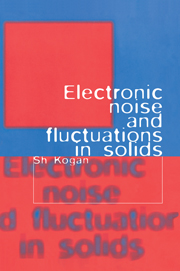Book contents
- Frontmatter
- Contents
- Preface
- Abbreviations
- 1 Introduction: Some basic concepts of the theory of random processes
- 2 Fluctuation–dissipation relations
- 3 Fluctuations in nonequilibrium gases
- 4 Generation–recombination noise
- 5 Noise in quantum ballistic systems
- 6 Resistance noise in metals
- 7 Noise in strongly disordered conductors
- 8 1/f noise and random telegraph noise
- 9 Noise in superconductors
- References
- Subject index
7 - Noise in strongly disordered conductors
Published online by Cambridge University Press: 17 March 2010
- Frontmatter
- Contents
- Preface
- Abbreviations
- 1 Introduction: Some basic concepts of the theory of random processes
- 2 Fluctuation–dissipation relations
- 3 Fluctuations in nonequilibrium gases
- 4 Generation–recombination noise
- 5 Noise in quantum ballistic systems
- 6 Resistance noise in metals
- 7 Noise in strongly disordered conductors
- 8 1/f noise and random telegraph noise
- 9 Noise in superconductors
- References
- Subject index
Summary
An enormous variety of conductors can be called strongly disordered. First of all, these are conductors prepared of macroscopically randomly inhomogeneous materials, i.e., various composites: dielectrics (polymers, plastics) into which in some proportion fine particles of metal or graphite are introduced, say, before hardening. Such material becomes conductive due to contacts between the particles of the conducting substance forming continuous chains between the electrodes attached to the whole sample. One may attribute to such conductors also cermets, polycrystalline solids in which each crystallite is strongly anisotropic (the material as a whole may be isotropic owing to random orientation of the crystallites), metallic films subjected to sandblasting (sand particles randomly remove some parts of the film), etc. In the simplest case the conducting particles are homogeneous within their boundaries, their dimensions are many times larger than the free-path length of the charge carriers, and the contacts between them are perfect. Real disordered materials, of course, are usually much more complex, and the simplest case described above can be considered merely as a model.
Semiconductors with hopping conductivity may also be attributed to strongly disordered conductors. The charge carriers are hopping between impurity centers by tunneling. Owing to the random distribution of impurity centers and strong, exponential, dependence of the tunneling probability on the distance between the impurities, the current paths are extremely intricate, as in randomly inhomogeneous media.
The static conductivity of disordered mixtures, one of the components of which is an insulator, tends to zero as the fraction p of the conductive component approaches from above a critical nonzero value pc. This phenomenon is a kind of metal-insulator transition.
- Type
- Chapter
- Information
- Electronic Noise and Fluctuations in Solids , pp. 190 - 202Publisher: Cambridge University PressPrint publication year: 1996
- 1
- Cited by

